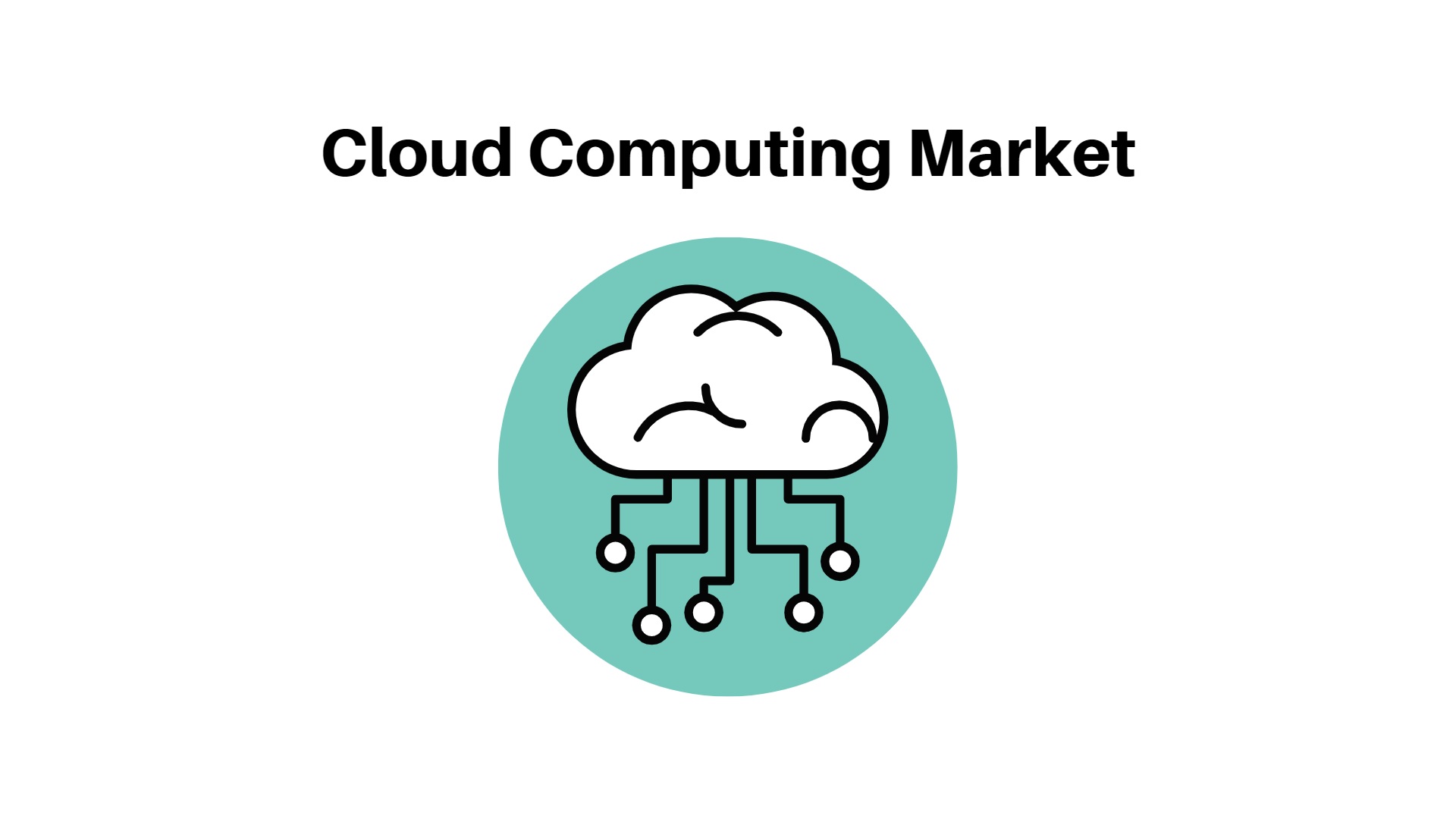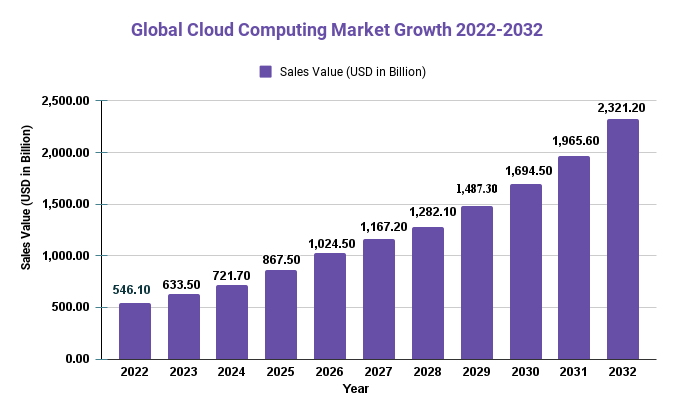Cloud Computing Market Size USD 2,321.2 bn | Vendors Analysis (Ingenico, Verifone) By 2032

Page Contents
Market Overview
Published Via 11Press: The cloud computing market was estimated to be worth USD 546.1 billion in 2022 and was expected to reach its peak value of USD 2,321.2 billion by 2032 at a compound annual growth rate (CAGR) of 16% between 2022 and 2032.
The cloud computing market has experienced rapid growth in recent years and is expected to remain so. Cloud computing refers to the delivery of computing services, such as software, storage, and processing power over the internet. These are usually managed and maintained by third-party vendors who manage and provide all necessary infrastructure.
Cloud computing was growing rapidly and was expected to keep doing so. Cloud computing refers to the delivery of computing services such as servers, storage, databases, networking, software, analytics, and intelligence over the internet (“the cloud”). Major players in this space include Amazon Web Services (AWS), Microsoft Azure, Google Cloud Platform IBM Cloud, and Alibaba Cloud; these companies provide infrastructure as a service (IaaS), platform as a service (PaaS), and software as a service (SaaS).
One trend in the cloud computing market is the growing adoption of hybrid cloud solutions, which combine public cloud services with private cloud or on-premises infrastructure. Organizations can take advantage of both public and private cloud computing while still having control over their data and applications. Another trend seen recently is the growing application of artificial intelligence (AI) and machine learning (ML) in cloud computing.
Cloud providers are increasingly providing AI and ML services to organizations, helping them make better use of their data and optimize business operations. Industry verticals such as healthcare, financial services, and retail are expected to be among the fastest adopters of cloud computing in coming years. Overall, analysts anticipate that the cloud computing market will maintain its growth trajectory over the coming years as more organizations turn towards cloud services for improved agility, scalability, and cost efficiency.
Drivers, trends, and challenges have an impact on market dynamics, which can impact businesses. Request for PDF sample report

Key Takeaways
- The global cloud computing market is projected to experience a compound annual growth rate (CAGR) of around 16% between 2022 and 2032.
- The market is being driven by factors such as the increasing adoption of cloud computing by businesses of all sizes, an uptick in hybrid cloud solutions, and growing applications within industries like healthcare, finance, and retail.
- Infrastructure as a Service (IaaS) is the leading segment of cloud computing, followed by Platform as a Service (PaaS) and Software as a Service (SaaS).
- The market is dominated by a few major players, such as Amazon Web Services, Microsoft Azure, and Google Cloud Platform; however, there are also numerous smaller players operating within it.
Regional Snapshot
North America leads the cloud computing market, followed by Europe and the Asia Pacific. This growth is being spurred on by factors such as the high adoption of cloud computing in the US and Canada, increasing demand for cloud services across Europe, and growing interest in cloud computing among countries like China, Japan, and India.
Drivers
- Businesses of all sizes are increasingly turning to cloud computing for its cost savings, scalability, and flexibility.
- A growing demand exists for hybrid cloud solutions which combine public and private cloud environments in order to offer businesses a more tailored solution.
- Cloud computing is becoming more widely adopted in industries such as healthcare, finance, and retail – which increasingly depend on digital solutions to meet customer demands.
- Technological advances such as artificial intelligence and the Internet of Things are creating a need for more powerful computing solutions.
Restraints
- Data security and privacy worries may prevent some businesses from adopting cloud computing.
- Inadequate standardization within the industry could also pose compatibility issues between different cloud providers.
- Regulations such as data localization requirements can hinder cloud providers' expansion into certain markets.
- A shortage of skilled personnel with expertise in cloud computing also poses challenges.
Opportunities
- Cost Reduction: Cloud computing offers businesses the primary benefit of cutting IT expenses. By using cloud-based services, companies don't need to invest in costly hardware and software – instead, they pay only for what they use.
- Scalability: Cloud computing enables businesses to quickly scale their resources up or down according to their demands. This flexibility gives companies the chance to adjust quickly in response to changes in demand or seize new opportunities.
- Increased Productivity: Cloud computing can assist businesses in increasing productivity by giving employees easy access to the tools and information necessary for their jobs. Cloud-based collaboration tools, for instance, allow teams to work more efficiently and effectively together.
Challenges
- Security: One of the primary concerns businesses have when utilizing cloud computing is security. Companies must guarantee their data is shielded against unauthorized access, theft, and other security threats.
- Dependence on Internet Connection: Since cloud computing services are accessible via the internet, businesses rely on a fast and reliable connection for operations. Any disruption in service could cause downtime as well as productivity losses.
- Integration with Existing Systems: Businesses that already have existing IT systems may find it challenging to integrate cloud-based services into their current infrastructure, leading to additional costs and complications.
Recent Developments
- Edge Computing: Edge computing is a cloud computing approach that brings computing resources closer to end-users or devices. This approach works best for applications requiring low latency, such as autonomous vehicles or real-time gaming.
- Multi-Cloud Strategies: Many businesses are now implementing multi-cloud strategies, which involve using multiple cloud providers to meet their various requirements. This approach can help mitigate the risks associated with vendor lock-in and boost resilience levels.
- Serverless Computing: Serverless computing is a modern form of cloud computing that enables businesses to run applications without the need for servers or infrastructure. This approach can reduce costs and boost scalability.
Кеу Маrkеt Ѕеgmеntѕ
Service
- Infrastructure as a Service(laas)
- Software as a Service (SaaS)
- Platform as a Service (PaaS)
Deployment
- Hybrid
- Private
- Public
Enterprise Size
- Small & Medium Enterprises
- Large Enterprises
End-use
- IT & Telecom
- BFSI
- Retail & Consumer Goods
- Energy & Utilities
- Manufacturing
- Government & Public Sector
- Media & Entertainment
- Healthcare
- Other End-uses
Маrkеt Кеу Рlауеrѕ
- Adobe Inc.
- Google LLC
- Alibaba Group Holding Limited
- International Business Machines Corporation
- com Inc.
- Oracle Corporation
- com Inc.
- Microsoft Corporation
- SAP SE
- Other Key Players
Report Scope
| Report Attribute | Details |
| The market size value in 2022 | USD 546.1 Bn |
| Revenue forecast by 2032 | USD 2,321.2 Bn |
| Growth Rate | CAGR Of 16% |
| Regions Covered | North America, Europe, Asia Pacific, Latin America, and Middle East & Africa, and Rest of the World |
| Historical Years | 2017-2022 |
| Base Year | 2022 |
| Estimated Year | 2023 |
| Short-Term Projection Year | 2028 |
| Long-Term Projected Year | 2032 |
Frequently Asked Questions
Q: What is cloud computing?
A: Cloud computing refers to the delivery of computing resources such as servers, storage, databases, and software over the internet.
Q: What are the advantages of cloud computing?
A: Cloud computing offers businesses numerous advantages, including cost reductions, increased productivity levels, and expanded scalability.
Q: Is cloud computing secure?
A: Cloud computing can be secure if proper security measures such as encryption, access controls, and monitoring are in place.
Q: What are the different types of cloud computing?
A: The three primary forms are public, private, and hybrid clouds.
Q: What is serverless computing?
A: Serverless computing is an innovative type of cloud computing that enables businesses to run applications without the need for servers or infrastructure.
The team behind market.us, marketresearch.biz, market.biz and more. Our purpose is to keep our customers ahead of the game with regard to the markets. They may fluctuate up or down, but we will help you to stay ahead of the curve in these market fluctuations. Our consistent growth and ability to deliver in-depth analyses and market insight has engaged genuine market players. They have faith in us to offer the data and information they require to make balanced and decisive marketing decisions.